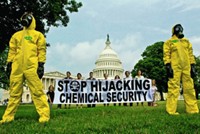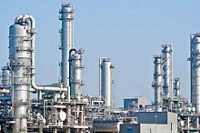Advertisement
Grab your lab coat. Let's get started
Welcome!
Welcome!
Create an account below to get 6 C&EN articles per month, receive newsletters and more - all free.
It seems this is your first time logging in online. Please enter the following information to continue.
As an ACS member you automatically get access to this site. All we need is few more details to create your reading experience.
Not you? Sign in with a different account.
Not you? Sign in with a different account.
ERROR 1
ERROR 1
ERROR 2
ERROR 2
ERROR 2
ERROR 2
ERROR 2
Password and Confirm password must match.
If you have an ACS member number, please enter it here so we can link this account to your membership. (optional)
ERROR 2
ACS values your privacy. By submitting your information, you are gaining access to C&EN and subscribing to our weekly newsletter. We use the information you provide to make your reading experience better, and we will never sell your data to third party members.
Safety
Greenpeace Targets Dupont Facilities
Environmental group draws attention to risks posed by use of toxic chemicals
by Glenn Hess
June 7, 2010
| A version of this story appeared in
Volume 88, Issue 23

The environmental group Greenpeace has taken its campaign against industrial use of chlorine to the air, using a giant green blimp to conduct “citizen inspections” of two DuPont chemical plants along the Delaware River.
The activists’ publicity stunt on May 21 was designed to focus attention on the potential risks posed by facilities that use chlorine and other toxic gases. The activists also wanted to build support for security legislation that would authorize the federal government to require the use of safer chemicals and processes at some facilities.
Greenpeace’s 135-foot thermal airship, marked with a banner that read “Real Chemical Security Now,” flew past DuPont’s Edge Moor plant, in Wilmington, Del., where the company uses chlorine in producing titanium dioxide pigments. The blimp also circled around DuPont’s sprawling 1,455-acre Chambers Works complex across the river in Deepwater, N.J., where chlorine-based phosgene is used to make polymers.
A terrorist attack or catastrophic accident at Chambers Works would endanger 2 million area residents because of the facility’s bulk use and storage of chlorine, says Greenpeace Legislative Director Rick Hind, who cites data from the Environmental Protection Agency’s risk management program.
“Putting up fences and cameras won’t protect workers and communities. Even a no-fly zone will only deter law-abiding pilots,” Hind remarks. “The only foolproof way to safeguard communities from these plants is to use safer, commonsense chemical processes that eliminate the possibility of a catastrophic accident.”
Eliminating or reducing the use of hazardous chemicals would also make facilities less attractive targets for terrorists, he adds. Hind notes that in November 2009, Clorox announced plans to move away from chlorine as a raw material in the production of household bleach at its seven U.S. facilities. “If Clorox can do it, why won’t DuPont? They simply lack the will do so,” Hind contends.
But F. Eddie Johnston, sustainability manager for DuPont Titanium Technologies, says that the firm is always looking for ways to reduce or eliminate hazards in its operations and improve efficiency.
“We believe that the process we use today that uses chlorine to make TiO2, for example, is the most efficient process that is available, both in terms of its energy consumption and its waste generation,” Johnston says. Returning to the less economical, older sulfate process “would be a move in the wrong direction. That’s really a nonstarter for us,” he says.
Another alternative to storing bulk quantities of chlorine on-site, Greenpeace says, is the adoption of “just-in-time” manufacturing processes, in which small amounts of the chemical are generated as needed.
“DuPont can choose the safer alternative best suited for their plant as long as it reduces catastrophic risks,” Hind tells C&EN.
DuPont has been working “to minimize inventories of all of our raw materials and that includes chlorine,” Johnston says. “So we already reduce storage to the extent that we can in order to maintain our operations.”
The environmental community supports a bill passed by the House of Representatives in November 2009 (H.R. 2868) that authorizes the Department of Homeland Security (DHS) to require the highest risk chemical plants to adopt so-called inherently safer technology (IST) where feasible to minimize risk. Sen. Frank R. Lautenberg (D-N.J.) has said he plans to introduce a similar measure in the Senate shortly.
DuPont and other chemical companies strongly oppose efforts to expand the scope of the current plant security law, which Congress passed in October 2006. Johnston argues that because DHS is still in the process of implementing the regulations—the Chemical Facility Antiterrorism Standards (CFATS)—an overhaul of the program now would be premature.
“One of our concerns is that while we’re implementing the existing regulations, that there would be additional requirements on top of that, before we’ve had an opportunity to evaluate” how well the current program works, Johnston says.
CFATS requires all high-risk chemical facilities to complete vulnerability assessments, develop site security plans, and implement protective measures necessary to meet DHS-defined risk-based performance standards.
The chemical industry is backing a bill (S. 2996) sponsored by Sen. Susan M. Collins (R-Maine) that would retain the current security regulations set to expire in October and extend them for five years. The measure does not include an IST mandate.
“We think mandatory implementation of IST is really inappropriate,” Johnston says. “We favor the bill that’s been introduced by Sen. Collins and think that is a better approach to reauthorization of CFATS.”





Join the conversation
Contact the reporter
Submit a Letter to the Editor for publication
Engage with us on Twitter